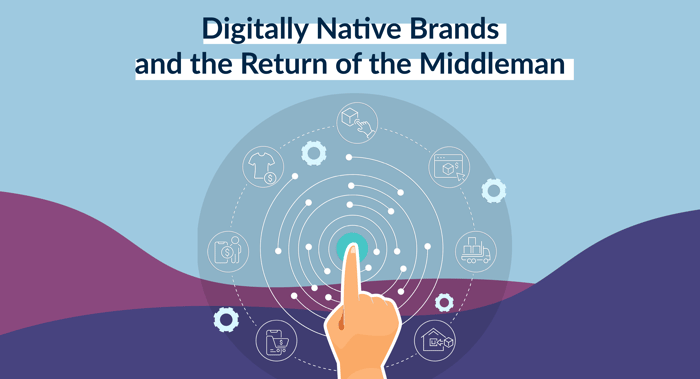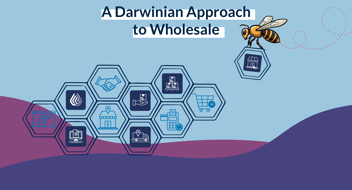CEO CORNER: Digitally Native Brands and the Return of the Middleman

Cutting out the middleman — a concept so old it can be traced all the way back to ancient Mesopotamia. But in the context of modern commerce, this simple idea is perhaps most famous for sparking the rise of digitally native brands (DNBs) in the 2000s and early 2010s.
Ignoring wholesale, these brands were designed from the ground up to operate in digital spaces. This enabled them to effectively harness the power of social media, technology, and data to their advantage.
DNBs promised consumers cheaper prices and a better customer experience, and for some time, they delivered. But nothing lasts forever. We’re living in times so ripe with change that future historians will look back at our era while rubbing their hands together in glee.
Not all DNBs have had their finger on the pulse, but the vast majority are now accepting that they need a physical presence. Some have launched their own stores, but those without the capital are beginning to recognize the advantages of selling wholesale. The middleman has returned.
Digitally Native Rise
For years this middleman was, figuratively speaking, out in the woods. Brands could smell opportunity and were drawn towards a digitally native, or strict direct-to-consumer (D2C) model. This allowed them to increase their margins, gain complete access to valuable consumer data through social media and digital ad campaigns, and forge (supposedly) long-term buying relationships with consumers.
With the pandemic limiting real-life movement, and the increasing buying power of Gen Z, the appeal of digital disruption has been clear to see. But despite this, it’s starting to dawn on many brands that a narrow approach to commerce will fail to provide them with long-term staying power.
Commerce’s Old Stomping Grounds
Consumers are flocking back to stores: Brick-and-mortar foot traffic for Q4 2022 was 9% higher than in Q4 2021. This could be a symptom of digital fatigue and a desire for a more tangible experience, or we may simply be seeing consumers return to pre-pandemic shopping habits.
A recent Forrester report concurs. It states that the percentage of online retail sales as a part of total retail sales “has settled to 2020 levels,” and forecasts three-quarters of all US sales occurring offline in 2023. Data from the Department of Commerce already puts that number as high as 85%. Regardless of whose statistics you’re looking at, it’s clear that brick-and-mortar is alive and well.
Even pre-pandemic, a significant number of DNBs were beginning to acknowledge the value of physical stores, particularly when it came to marketing and consumer acquisition. While digital models may yield higher margins and provide access to more consumer data, they also carry higher advertising and operating costs.
Wholesale, in comparison, doesn’t offer quite so eye-opening margins, but does give access to a far wider audience. With access to a larger consumer base, brands can administer more efficient marketing campaigns and significantly boost their ROI.
The Best of Both Worlds
It may feel like I’m laying into DNBs while singing the praises of brick and mortar, but the truth is that focusing on either D2C or wholesale alone is never the answer. To thrive in such turbulent times, brands must be able to both sell to consumers through their websites and provide them with a seamless in-store experience.
If you’re thinking that sounds like an omnichannel approach then you’d be right. I’ve said it before and I’ll say it again, the future of commerce is omnichannel. But so is the present.
Far too many digitally native brands ignore the fact that omnichannel shoppers have a 30% higher lifetime value than those who shop using only one channel. And in times when customer loyalty is hard to come by, why aren’t more businesses adopting omnichannel strategies that could give them a 91% higher customer retention rate? I could go on listing stats at you, but the simple fact of the matter is you can’t ignore omnichannel.
The Forrester report I mentioned earlier forecasts US consumers ramping up cross-channel shopping in 2023 and increasingly using popular fulfillment options like Buy Online, Pick Up In-Store (BOPIS). This is set to be the year when omnichannel solidifies its status as the most resilient approach to commerce. But a big year for omnichannel comes at the expense of a bad one for those who neglect it.
The Digitally Native Downfall
Recent S&P Global Market Intelligence data shows that digitally native retailers have the highest median market signal one-year probability of default of any sector (8.1%). We’re barely into the year and many digitally native brands are already laying off staff to cut costs. One DNB, Forma Brands, has even been forced to file for Chapter 11 bankruptcy, and many more are on the brink.
But where did it all go wrong? Well, the supply chain crisis hasn’t disappeared overnight — its reverberations will continue to be felt for a long time. Likewise, factory shutdowns and the war in Ukraine mean many brands are still struggling with raw materials and shipping. It’s also undeniable that inflation has raised costs and forced consumers to make fewer discretionary purchases. But none of these issues uniquely affect digitally native brands.
The real reason DNBs are suffering is because of an inherent problem with their model. Depending on how you look at it, the Internet is an opportunity, a great expansive playground, or an endless void. Whatever your perspective, it's clear that there’s an incredible amount of competition online and that attracting consumers can be hard. Customer acquisition costs add up and often come at the expense of profitability. Statistically speaking, pure-play ecommerce companies are twice as likely (44% versus 20%) as retailers who have stores to report being unprofitable.
To illustrate how vulnerable a strictly D2C model can be, let’s take a look at one of the biggest DNB stories of the last few years, Peloton.
Peloton was already gaining momentum before COVID-19 struck, but experienced a surge in growth in the early days of the pandemic by offering a solution to shuttered gyms. Unfortunately, the connected fitness company made the mistake of assuming demand would last after the pandemic subsided and restrictions were lifted. From hitting a peak of $167 in December 2020, Peloton’s stock has crumbled to around $12 a share — less than half of its opening price of $27. One need only look at the brand’s market cap to see the extent of its downfall — from a colossal $45 billion, down to ~$4 billion.
Peloton got a lot wrong, including frequent reckless spending on the final mile delivery. In some regions, the exercise bike brand was spending almost $500 per order on the final mile, not including initial shipping costs from overseas. This lack of consideration for shipping costs is not unique to the exercise equipment company, with other DNBs also falling foul of overspending.
While Peloton’s reckless spending and naivety is an example of how not to run a digitally native brand, recent decision-making shows the company moving in the right direction. The new CEO, Barry McCarthy, has made big changes, and as of the end of the most recent fiscal quarter, Peloton has brought free cash flow levels from -$747 million down to -$94 million.
Part of Peloton’s rescue strategy has been to focus on software and subscription revenue rather than hardware. But just as noteworthy has been the decision to open Peloton up as a wholesaler. Last September’s partnership with Dick’s Sporting Goods was a turn in the right direction — and a belated acceptance of the importance of brick and mortar.
The Digitally Native Rewind
Peloton isn’t the only digitally native brand making moves into wholesale. In recent times, DNBs including Allbirds, Adore Me, Bonobos, Casper, and Warby Parker have also ventured into brick-and-mortar.
Critics may point out that some of these brands are still struggling, but they’d be missing the point. These DNBs have accepted that the very conventions they sought to disrupt now provide them with their best opportunity. In acknowledging that a pure D2C model wasn’t working and accepting that an in-store presence is critical, these brands have given their business the best chance of flourishing.
When it comes to modern-day fulfillment, three of the commerce world’s biggest players are unavoidable. Amazon, Walmart, and Target have set the standard for quick and free online order fulfillment by offering fast delivery and store pick-up options. They’ve raised the bar and consumers now expect smaller companies without access to the same resources to deliver the same convenience and speedy delivery. Taking on these giants at their own game will only end badly, but by forging connections with stores, digitally native brands can reach modern standards and provide satisfactory fulfillment.
An Omni-Solution
For too long, digitally native brands have been failing to keep up with consumer preferences. Around 90% of consumers expect a brand to offer an omnichannel experience, and these shoppers put their money where their mouth is by spending 10% more online and 4% more in-store than single-channel customers.
Some DNBs are rightfully concerned about an assumed loss of control involved in selling wholesale. The good news is that with Quivers’ brand of omnichannel, brands don’t lose control — they gain it. While the connection Quivers forges between brands and retailers benefits both parties, brands always maintain full control over the conditions of their partnerships with retailers.
Another common wholesale fear is that brands could lose the type of consumer data that made their digitally native strategy so attractive in the first place. With Quivers, brands not only keep this data but also gain additional intelligence. There’s real-time access to data from online orders fulfilled by retailers, and with Quivers’ Sell-Through Reports, a full breakdown of sales made on the shop floor. Quivers’ software integrates with leading commerce platforms and plugins, ensuring a streamlined, data-enriched experience. Having access to so much actionable data empowers brands to make data-driven decisions and helps invigorate future product development and marketing strategies.
We’re living in changing times and when push comes to shove, neither being exclusively digitally native nor limiting yourself to wholesale is the answer. The best approach is to give your brand resilience with healthier distribution models, more sales channels, and stronger connections. By facilitating a robust omnichannel experience, Quivers blurs the line between D2C and wholesale and creates a collaborative world of commerce that benefits everyone, especially consumers.



